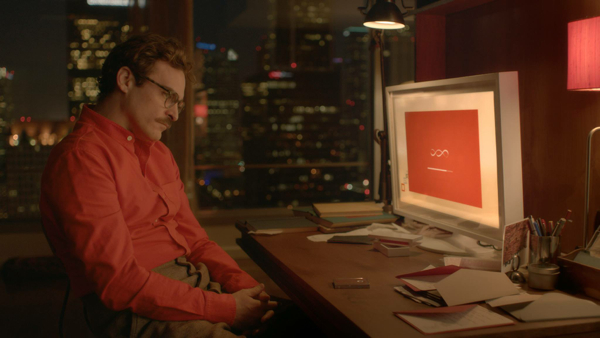Movie review by Greg Carlson
Since his 1999 feature debut “Being John Malkovich,” Spike Jonze has established himself as one of the most gifted and intelligent visual stylists working in the cinematic medium. Jonze’s latest, “Her,” is only the director’s fourth feature and is the first full-length original screenplay credited solely to the auteur. An ambitious science fiction that contemplates artificial intelligence and human-computer interaction, “Her” is another child of “2001: A Space Odyssey” and the unforgettable HAL 9000. The core concept is elegant and simple: lonely, soon to be divorced protagonist Theodore Twombly (Joaquin Phoenix), whose expressive face dominates the frame, falls in love with Samantha (Scarlett Johansson), a self-aware operating system.
As emotionally isolated Theodore, a writer who composes personal missives for a company called Beautifulhandwrittenletters.com, establishes an affectionate partnership with the disembodied Samantha, he also interacts with several human women, including close friend Amy (Amy Adams), a blind date played by Olivia Wilde, and wife Catherine (Rooney Mara), who is often seen in flashback. Those who speculated that Jonze was the inspiration for Giovanni Ribisi’s John in ex-wife Sofia Coppola’s “Lost in Translation” will wonder whether the director has returned the favor, even though extratextual biographical conjecture is unnecessary to one’s enjoyment of the film.
Edmund Lee’s idea about the value of surrounding yourself with the “dreamers and the doers” etc., is a lesson well-minded by Jonze. Many team members, including cinematographer Hoyte van Hoytema, bring remarkable craft to bear, but it is K. K. Barrett, production designer on all of Jonze’s features, who emerges as perhaps the most significant hero of “Her.” Barrett’s eye for detail in the creation of future L.A. infuses every frame of the movie, offering an uncanny vision of things to come via the retrofitting and retro-futurism concepts explored in the early 1980s by Ridley Scott, Syd Mead, Lawrence Paull, and Lloyd Dunn, among others. The gorgeous rosy red and pink color schemes, the seamless blending of Los Angeles and Shanghai, and the warm touches of smartphones that look more like vintage cigarette cases are just a few of the film’s ocular pleasures.
One of the movie’s best running gags is that the earpiece-connected pedestrians never talk to the other humans passing by. Rich with the possibilities of near endless readings, “Her” has been tagged out of the gate for its commentary on intimacy and interconnectedness in the age of evolving competition from electronic screens, but it is the juxtaposition of the film’s intriguing femininity and the establishment of straight male fantasies through the reification of Samantha that deserves closer inspection. As Manohla Dargis pointed out, Samantha “doesn’t complain about juggling her many roles as [Theodore’s] assistant, comfort, turn-on, helpmate and savior,” which leads one to wonder how the story might have been different had Jonze switched the genders of the leads.
Jonze plays the romance almost entirely straight, so that by the time Samantha’s evolving consciousness leads her to disclose several disturbing revelations to Theodore, “Her” begins to flirt with the Frankensteinian “turning on the creator” construct that has fueled everything from the homicidal deviousness of HAL to the dystopian horrors of Skynet, and given Jonze’s penchant for offbeat bricolage, even “Electric Dreams” and “Weird Science.” The relaxed running time of the theatrical cut allows for a late, minor stretch of repetitious droop, and I for one would love to see the 90 minute Steven Soderbergh version described in Mark Harris’s tremendous, must-read “Vulture” feature on “Her.”
